Hi Everyone,
Who is up for the challenge of helping me tame this difficult apartment? What do I need to do to make this room sound bearable? My main issue is the lack of clarity with movie dialogue and music just sounds muddled in general.
Speakers are B&W 805s medium size (10 Litres) bookshelf speakers with front firing bass ports. No sub. Wall mounted TV
The attached photos and layout show the hard surfaces and complete lack of symmetry. Measurements of listening position and waterall plots attached.
1 . What type of treatments and thickness of panels do I need and where do prioritise placement of them?
2. Do I plug the front ports of the speakers? I used some socks as an experiment and there is a drastic change in the measured base. It looks better with the ports blocked with socks, are there any other trade offs not shown in the frequency response chart?
3. Where can I get help or good resources. Will consider paying the right person for good advice.
4. Is a subwoofer needed (I only care about music though)
5. Do I need a rug?
6. Are panels on the ceiling worth considering?
My initial instinct is to get a bunch of artwork printed on canvas and stuff with rockwool or similar.
The below website recommends 16cm (6″) deep material with a weight of 40kg/m3 (2.5lb/cft).
https://www.acousticsinsider.com/best-insulation-material-diy-acoustic-absorbers/
That's some pretty chunky panels. Do I really need ones this deep? I'm just hifi listener not a recording studio.
Can I prioritise placement of deep panels and use ones 3" 8cm deep for the majority.
Thanks for your assistance!
Who is up for the challenge of helping me tame this difficult apartment? What do I need to do to make this room sound bearable? My main issue is the lack of clarity with movie dialogue and music just sounds muddled in general.
Speakers are B&W 805s medium size (10 Litres) bookshelf speakers with front firing bass ports. No sub. Wall mounted TV
The attached photos and layout show the hard surfaces and complete lack of symmetry. Measurements of listening position and waterall plots attached.
1 . What type of treatments and thickness of panels do I need and where do prioritise placement of them?
2. Do I plug the front ports of the speakers? I used some socks as an experiment and there is a drastic change in the measured base. It looks better with the ports blocked with socks, are there any other trade offs not shown in the frequency response chart?
3. Where can I get help or good resources. Will consider paying the right person for good advice.
4. Is a subwoofer needed (I only care about music though)
5. Do I need a rug?
6. Are panels on the ceiling worth considering?
My initial instinct is to get a bunch of artwork printed on canvas and stuff with rockwool or similar.
The below website recommends 16cm (6″) deep material with a weight of 40kg/m3 (2.5lb/cft).
https://www.acousticsinsider.com/best-insulation-material-diy-acoustic-absorbers/
That's some pretty chunky panels. Do I really need ones this deep? I'm just hifi listener not a recording studio.
Can I prioritise placement of deep panels and use ones 3" 8cm deep for the majority.
Thanks for your assistance!
Attachments
-
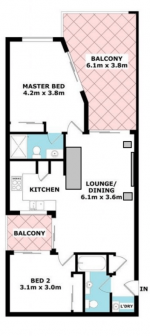 Room layout.png76.9 KB · Views: 207
Room layout.png76.9 KB · Views: 207 -
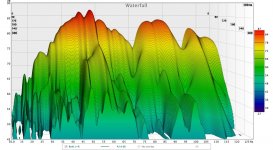 Both L +R waterfall.jpg250.7 KB · Views: 188
Both L +R waterfall.jpg250.7 KB · Views: 188 -
 Both Channels 1-12 smooth.jpg151.2 KB · Views: 169
Both Channels 1-12 smooth.jpg151.2 KB · Views: 169 -
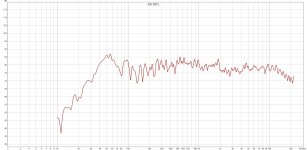 Both Channels 1-24 smooth.jpg161.6 KB · Views: 161
Both Channels 1-24 smooth.jpg161.6 KB · Views: 161 -
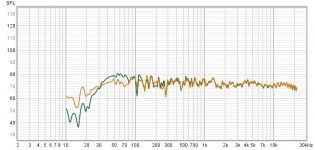 Sock vs no sock.jpg82.5 KB · Views: 200
Sock vs no sock.jpg82.5 KB · Views: 200 -
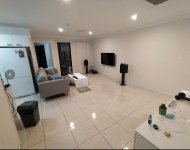 picture 1.JPG369.7 KB · Views: 193
picture 1.JPG369.7 KB · Views: 193 -
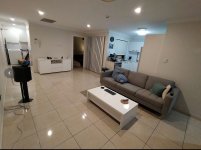 picture 2.JPG360.9 KB · Views: 194
picture 2.JPG360.9 KB · Views: 194 -
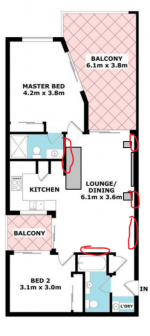 Room layout with possible locations in red.png77.9 KB · Views: 198
Room layout with possible locations in red.png77.9 KB · Views: 198
for speech purposes, you will need a BAD panel 60 x 120cm rise 60cm from the floor. use a 10cm frame for 12mm BAD panels and put a 2cm acoustic foam behind it.
put it at your first reflection point.
put it at your first reflection point.
Interesting! Some challenging placement, but I am definitely to a relocatable panel system that I put in place when I'm having a session or watching a movie.
You dont have to spend alot of money or hire an expert. The problem is too much high freq. reflections.
That floor tiles look very reflective to high frequencies, so start with nice rug, 2x3 meters placed between sofa and speakers.
Next, replace the balcony doors curtains with curtains made of some acoustic absorbent cloth. And last, install same curtains (same lenght and material) on the right side of speakers, symmetricaly. That will isolate your listening area from rest of the space on the right and give it symmetric behaviour. Plus, curtains are adjustable so you can experiment with amount of absorption to find best results, and when you dont listen/watch anything you can simply fold them.
Regarding subwoofer, if you are satisfied with bass of your speakers I dont see any reason for it.
That floor tiles look very reflective to high frequencies, so start with nice rug, 2x3 meters placed between sofa and speakers.
Next, replace the balcony doors curtains with curtains made of some acoustic absorbent cloth. And last, install same curtains (same lenght and material) on the right side of speakers, symmetricaly. That will isolate your listening area from rest of the space on the right and give it symmetric behaviour. Plus, curtains are adjustable so you can experiment with amount of absorption to find best results, and when you dont listen/watch anything you can simply fold them.
Regarding subwoofer, if you are satisfied with bass of your speakers I dont see any reason for it.
yes thats exactly how i suggested, something that you can move around easily.Interesting! Some challenging placement, but I am definitely to a relocatable panel system that I put in place when I'm having a session or watching a movie.
Large, plush pile carpet in the listening area would be a good starting point. Some absorptive, refractive wall coverings behind the speakers and listening position would be a next step. Need to control HF reflections.
Hello Spierdolony,
I think the biggest improvement will come from moving your listening position away from the rear wall. The presence of the wall creates interfering reflections due to phantom images behind the wall. There's no upper limit on how far, the further the better. Similarly, spacing the speakers away from the walls for the same reason. I can see that will be difficult without compromising your living space so perhaps sound absorbing material on the wall behind the listening position and possibly also, but less importantly, behind the speakers is your only option here
Further application of absorbing materials at primary reflection points as mentioned by others is also a good idea but the main problem lateral reflection will come from your sliding door to the balcony and will be difficult to treat due to its construction. Reflections from the floor can be helped with a rug as you've mentioned and it's important not to forget the ceiling, ceiling treatment can be quite effective and visually unobtrusive
The thickness of the absorber is determined by the lowest operating frequency. In this application you are interested in higher frequency efficacy and will not be trying to control low frequency room modes so an absorber that works above a few hundred Hertz is OK. Typically 50mm of acoustic open cell foam will be a good starting point and if possible space the absorber away from the wall by a similar distance (any distance will help) because material closest to the wall is not very effective as the air particle velocity at a boundary is zero
A secondary consideration are low frequency room modes, in particular the two modes near 50Hz and to a lesser extent those near 95Hz as shown in the waterfall plot. These hold a lot of energy and decay slowly. The location of the modes are due to room dimensions, source and listening positions. Some placement experimentation will be needed to try to minimise audibility of these modes and to better excite the regions at 80Hz and 130Hz where little energy is present
Subs can help. Multiple small subs as advocated by Toole and Gedees are the most effective and excite the room modes most evenly. Blocking the speaker ports can also help and is a good idea if you don't listen at high volume. Sound absorbing material doesn't really work at low frequencies but resonators can be effective for additive modes if correctly tuned and positioned
The best thing I can recommend is to buy copy Floyd Tooles book on acoustics in small rooms, a terrific resource!
https://books.google.com.au/books/about/Sound_Reproduction.html?id=sGmz0yONYFcC&redir_esc=y
I think the biggest improvement will come from moving your listening position away from the rear wall. The presence of the wall creates interfering reflections due to phantom images behind the wall. There's no upper limit on how far, the further the better. Similarly, spacing the speakers away from the walls for the same reason. I can see that will be difficult without compromising your living space so perhaps sound absorbing material on the wall behind the listening position and possibly also, but less importantly, behind the speakers is your only option here
Further application of absorbing materials at primary reflection points as mentioned by others is also a good idea but the main problem lateral reflection will come from your sliding door to the balcony and will be difficult to treat due to its construction. Reflections from the floor can be helped with a rug as you've mentioned and it's important not to forget the ceiling, ceiling treatment can be quite effective and visually unobtrusive
The thickness of the absorber is determined by the lowest operating frequency. In this application you are interested in higher frequency efficacy and will not be trying to control low frequency room modes so an absorber that works above a few hundred Hertz is OK. Typically 50mm of acoustic open cell foam will be a good starting point and if possible space the absorber away from the wall by a similar distance (any distance will help) because material closest to the wall is not very effective as the air particle velocity at a boundary is zero
A secondary consideration are low frequency room modes, in particular the two modes near 50Hz and to a lesser extent those near 95Hz as shown in the waterfall plot. These hold a lot of energy and decay slowly. The location of the modes are due to room dimensions, source and listening positions. Some placement experimentation will be needed to try to minimise audibility of these modes and to better excite the regions at 80Hz and 130Hz where little energy is present
Subs can help. Multiple small subs as advocated by Toole and Gedees are the most effective and excite the room modes most evenly. Blocking the speaker ports can also help and is a good idea if you don't listen at high volume. Sound absorbing material doesn't really work at low frequencies but resonators can be effective for additive modes if correctly tuned and positioned
The best thing I can recommend is to buy copy Floyd Tooles book on acoustics in small rooms, a terrific resource!
https://books.google.com.au/books/about/Sound_Reproduction.html?id=sGmz0yONYFcC&redir_esc=y
Thank you all for being generous with your knowledge. My current thoughts are to incorporate much of the advice given so far including.
There is not much flexibility for optimising placement, but I will try and of course take measurements.
I've been trying to find cost effective acoustic panels and think I've found a very cheap and hopefully attractive solution.
2.4 m x 1.2 m x 50 mm polyester sheeting
https://pricewiseinsulation.com.au/...0/03/Autex-Quietspace-Panel-Brochure-2019.pdf
The pricing works out to the equivalent of 12 panels at 1.2 x 0.6 m for $ 70 AUD ($50 USD) each.
The next cheapest commercial panels that are attractive enough are from CMF Acoustics which don't require cutting.
50 mm ceiling panels. 1.2 x 0.6 m. $95 AUD ($70 USD)
https://www.cmfacoustics.com.au/eco_acoustic_board.htm
75 mm 1.2 x 0.6 m. $170 ($125 USD)
https://www.cmfacoustics.com.au/acousticproducts.htm
- Rug
- 50 mm panels behind lounge
- 50 mm panels behind speakers
- 50 mm panels to ceiling
- Thick curtains
- Panel at 1st reflection point on glass sliding door
There is not much flexibility for optimising placement, but I will try and of course take measurements.
I've been trying to find cost effective acoustic panels and think I've found a very cheap and hopefully attractive solution.
2.4 m x 1.2 m x 50 mm polyester sheeting
https://pricewiseinsulation.com.au/...0/03/Autex-Quietspace-Panel-Brochure-2019.pdf
The pricing works out to the equivalent of 12 panels at 1.2 x 0.6 m for $ 70 AUD ($50 USD) each.
The next cheapest commercial panels that are attractive enough are from CMF Acoustics which don't require cutting.
50 mm ceiling panels. 1.2 x 0.6 m. $95 AUD ($70 USD)
https://www.cmfacoustics.com.au/eco_acoustic_board.htm
75 mm 1.2 x 0.6 m. $170 ($125 USD)
https://www.cmfacoustics.com.au/acousticproducts.htm
From the photos your room looks like a nightmare due to untreated large hard surfaces, you need to decrease reverberation time. i would recommend put in a lot of sound absorbers, large ones that is effective to low frequencies. Start with corners and midpoint between walls and midpoints between midpoints, get thick ruggs and cover as much area as possible, do not leave floorspace near the walls untreated. It is better to treat floorarea close to walls then in the middle of the room if you must choose. Then you can start to ad spices.
The imaging is reflections within 2 feet. Most critical.
There are a lot of DIY for the home studio and you can find good construction ideas. Owens Corning your friend.
There are a lot of DIY for the home studio and you can find good construction ideas. Owens Corning your friend.
^to clarify, I guess you mean path length difference of 2 feet ~2ms? Because for example floor reflection can happen about ~4 feet away from the speaker, about half listening distance, but resulting path length difference between it and direct sound is perhaps ~1 foot, which is eventually the delay of the reflected signal at listening position. Front wall is another, if wall is 2 feet behind the speaker the delay is 4 feet because it is a round trip to listening position.
- Home
- General Interest
- Room Acoustics & Mods
- Apartment Room Acoustics - panel placement and design